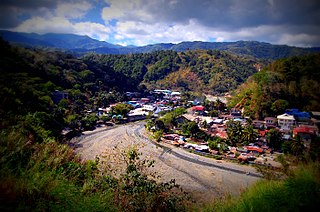
Nueva Vizcaya, officially the Province of Nueva Vizcaya, is a landlocked province in the Philippines located in the Cagayan Valley region in Luzon. Its capital is Bayombong. It is bordered by Benguet to the west, Ifugao to the north, Isabela to the northeast, Quirino to the east, Aurora to the southeast, Nueva Ecija to the south, and Pangasinan to the southwest. Quirino province was created from Nueva Vizcaya in 1966.

Quirino, officially the Province of Quirino, is a landlocked province in the Philippines located in the Cagayan Valley region in Luzon. Its capital is Cabarroguis. It is named after Elpidio Quirino, the sixth President of the Philippines.
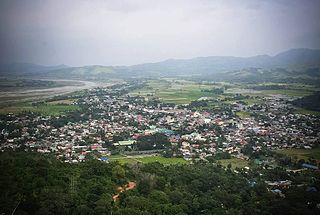
Bambang, officially the Municipality of Bambang, is a 1st class municipality in the province of Nueva Vizcaya, Philippines. According to the 2020 censusus, it has a population of 55,789 people.

Bagabag, officially the Municipality of Bagabag, is a 2nd class municipality in the province of Nueva Vizcaya, Philippines. According to the 2020 census, it has a population of 37,985 people.

Alfonso Castañeda, officially the Municipality of Alfonso Castañeda, is a 1st class municipality in the province of Nueva Vizcaya, Philippines. According to the 2020 census, it has a population of 8,539 people, making it the least populated municipality in the province.

Ambaguio, officially the Municipality of Ambaguio, is a 5th class municipality in the province of Nueva Vizcaya, Philippines. According to the 2020 census, it has a population of 15,472 people.

Bayombong, officially the Municipality of Bayombong, is a 1st class municipality and capital of the province of Nueva Vizcaya, Philippines. According to the 2020 census, it has a population of 67,714 people.

Diadi, officially the Municipality of Diadi, is a 4th class municipality in the province of Nueva Vizcaya, Philippines. According to the 2020 census, it has a population of 19,236 people.
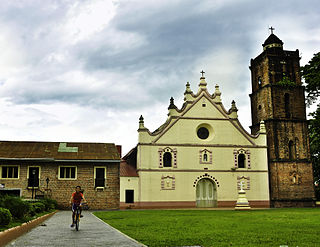
Dupax del Sur, officially the Municipality of Dupax del Sur, is a 2nd class municipality in the province of Nueva Vizcaya, Philippines. At the 2020 census, it had a population of 21,224 people.

Kayapa, officially the Municipality of Kayapa, is a 3rd class municipality in the province of Nueva Vizcaya, Philippines. According to the 2020 census, it has a population of 26,469 people.

Santa Fe, officially the Municipality of Santa Fe, is a 3rd class, landlocked municipality in the province of Nueva Vizcaya, Philippines. According to the 2020 census, it has a population of 18,276.

Solano, officially the Municipality of Solano, is a 1st class municipality in the province of Nueva Vizcaya, Philippines. According to the 2020 census, it has a population of 65,287 inhabitants..

Villaverde, officially the Municipality of Villaverde, also spelled as Villa Verde, is a 5th class municipality in the province of Nueva Vizcaya, Philippines. According to the 2020 census, it has a population of 20,118 people.
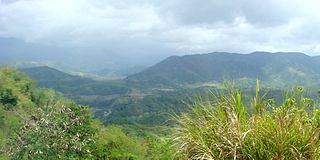
Pantabangan, officially the Municipality of Pantabangan, is a 1st class municipality in the province of Nueva Ecija, Philippines. According to the 2020 census, it has a population of 31,763 people.

Philippine Science High School – Cagayan Valley Campus (PSHS–CVC) is a campus of the Philippine Science High School System, a specialized public high school that admits and provides scholarships to high school students primarily from the Cagayan Valley region. It is located in Barangay Masoc, Bayombong, Nueva Vizcaya. Prior to its inclusion into the PSHSS, the school was named the Nueva Vizcaya Science High School, and was located at the Nueva Vizcaya State University compound. It first opened in 1996, four years after the law that created the school had passed in Congress.

Nueva Vizcaya State University is a public university in the Philippines. It is mandated to provide advanced instruction and professional training in agriculture, arts, science, technology, education and other related fields. It is also mandated to undertake research and extension services, and provide progressive leadership in its area of specialization. Its main campus is located in Bayombong, Nueva Vizcaya, Philippines.

The Gaddang are an indigenous peoples and a linguistically identified ethnic group resident in the watershed of the Cagayan River in Northern Luzon, Philippines. Gaddang speakers were recently reported to number as many as 30,000, a number that may not include another 6,000 related Ga'dang speakers or other small linguistic-groups whose vocabularies are more than 75% identical.
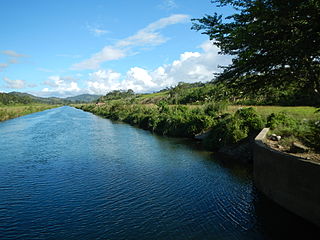
The Casecnan Protected Landscape is a protected area in the Casecnan River watershed of eastern Luzon in the Philippines. It has a total area of 88,846.80 hectares straddling the provinces of Nueva Vizcaya, Quirino and Aurora. The 57,930-hectare (143,100-acre) Casecnan River Watershed Forest Reserve was established in August 1987 by virtue of Executive Order No. 136 issued by President Corazon Aquino. In April 2000, the forest reserve was enlarged to 88,846.80 hectares and was reclassified as a protected landscape area through Proclamation No. 289. It is considered one of the last remaining substantial water sources for the region of Central Luzon.

Carlos Mapili Padilla was a Filipino politician who served as the Governor of Nueva Vizcaya from 2016 until his death in 2023. Padilla was elected to his first term as Governor in 2016 and was re-elected in 2019 and 2022.

Leonardo Balagot Perez was a Filipino politician who served as a member of the Philippine House of Representatives on behalf of the province of Nueva Vizcaya. He was a member of the Senate of the Philippines, and served in the cabinet of President Ferdinand Marcos.



















